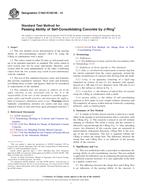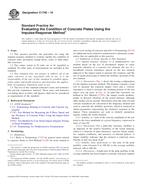Wir benötigen Ihre Einwilligung zur Verwendung der einzelnen Daten, damit Sie unter anderem Informationen zu Ihren Interessen einsehen können. Klicken Sie auf "OK", um Ihre Zustimmung zu erteilen.
ASTM C1621/C1621M-14
Standard Test Method for Passing Ability of Self-Consolidating Concrete by J-Ring
Automatische name übersetzung:
Standard Test Method for Passing Ability von Selbstverdichtender Beton von J-Ring
NORM herausgegeben am 1.4.2014
Informationen über die Norm:
Bezeichnung normen: ASTM C1621/C1621M-14
Anmerkung: UNGÜLTIG
Ausgabedatum normen: 1.4.2014
SKU: NS-12055
Zahl der Seiten: 5
Gewicht ca.: 15 g (0.03 Pfund)
Land: Amerikanische technische Norm
Kategorie: Technische Normen ASTM
Kategorie - ähnliche Normen:
Die Annotation des Normtextes ASTM C1621/C1621M-14 :
Keywords:
halo, j-ring, j-ring flow, passing ability self-consolidating concrete, slump flow, spread, ICS Number Code 91.100.30 (Concrete and concrete products)
Ergänzende Informationen
| Significance and Use | ||||||||||
|
5.1 This test method provides a procedure to determine the passing ability of self-consolidating concrete. This test method is applicable for laboratory use in comparing the passing ability of different concrete mixtures. It is also applicable in the field as a quality control test. 5.2 The difference between the slump flow and J-Ring flow is an indication of the passing ability of the concrete. A difference less than 25 mm [1 in.] indicates good passing ability and a difference greater than 50 mm [2 in.] indicates poor passing ability. The orientation of the mold for the J-Ring test and for the slump flow test without the J-Ring shall be the same. 5.3 This test method is limited to self-consolidating concrete with nominal maximum size of aggregate of up to 25 mm [1 in.]. |
||||||||||
| 1. Scope | ||||||||||
|
1.1 This test method covers determination of the passing ability of self-consolidating concrete (SCC) by using the J-Ring in combination with a mold. 1.2 The values stated in either SI units or inch-pound units are to be regarded separately as standard. The values stated in each system may not be exact equivalents; therefore, each system shall be used independently of the other. Combining values from the two systems may result in non-conformance with the standard. 1.3 The text of this standard references notes and footnotes that provide explanatory material. These notes and footnotes (excluding those in tables and figures) shall not be considered as requirements of the standard. 1.4 This standard does not purport to address all of the safety concerns, if any, associated with its use. It is the responsibility of the user of this standard to establish appropriate safety and health practices and determine the applicability of regulatory limitations prior to use. (Warning—Fresh hydraulic cementitious mixtures are caustic and may cause chemical burns to skin and tissue upon prolonged exposure.2) |
||||||||||
| 2. Referenced Documents | ||||||||||
|
Ähnliche Normen:
Historisch
15.12.2010
Historisch
1.11.2013
Historisch
1.5.2012
Historisch
1.8.2013
Historisch
1.6.2013
Historisch
1.1.2012
Empfehlungen:
Aktualisierung der technischen Normen
Wollen Sie sich sicher sein, dass Sie nur die gültigen technischen Normen verwenden?
Wir bieten Ihnen eine Lösung, die Ihnen eine Monatsübersicht über die Aktualität der von Ihnen angewandten Normen sicher stellt.
Brauchen Sie mehr Informationen? Sehen Sie sich diese Seite an.



 ASTM C1740-10
ASTM C1740-10 ASTM C1747/C1747M-13..
ASTM C1747/C1747M-13.. ASTM C1754/C1754M-12..
ASTM C1754/C1754M-12.. ASTM C1757-13
ASTM C1757-13 ASTM C1758/C1758M-13..
ASTM C1758/C1758M-13.. ASTM C1760-12
ASTM C1760-12
 Cookies
Cookies
